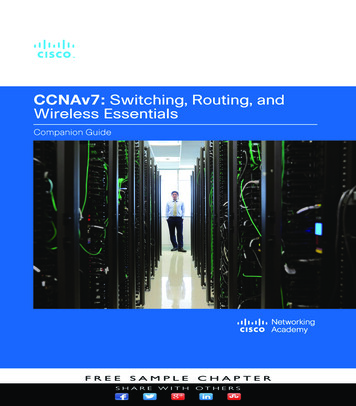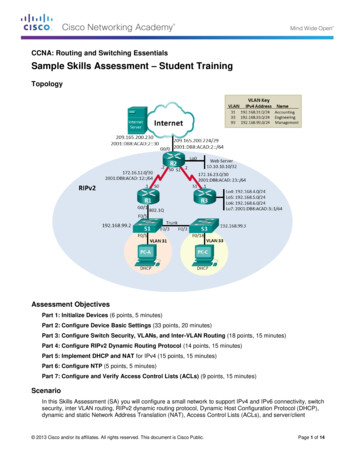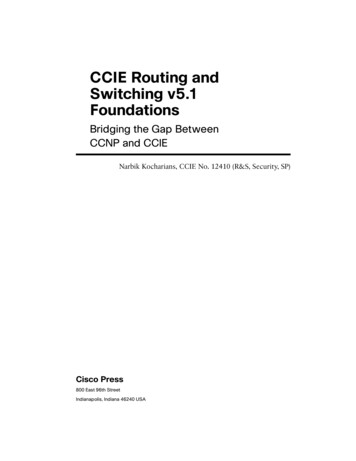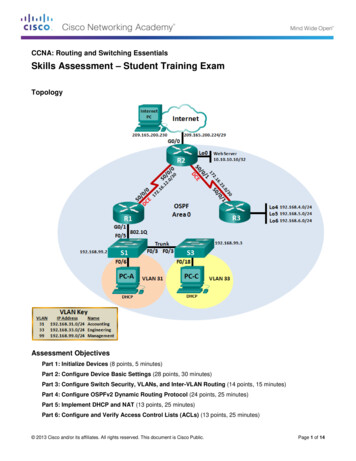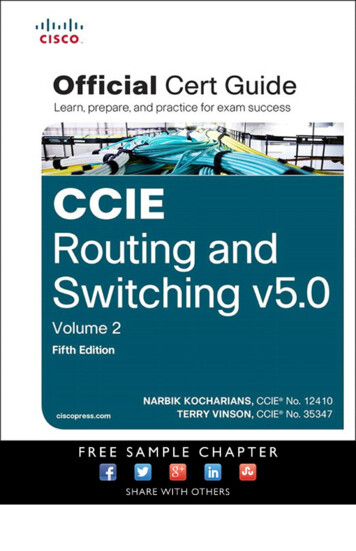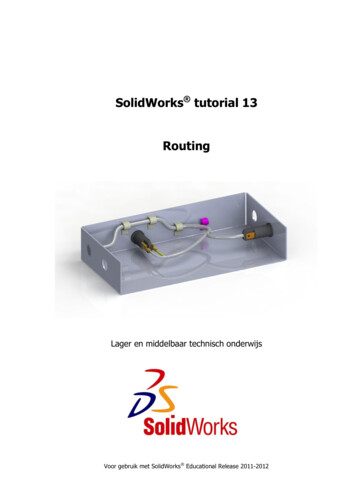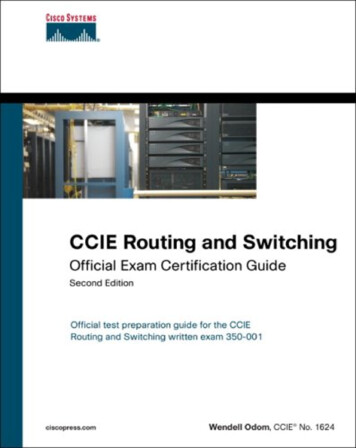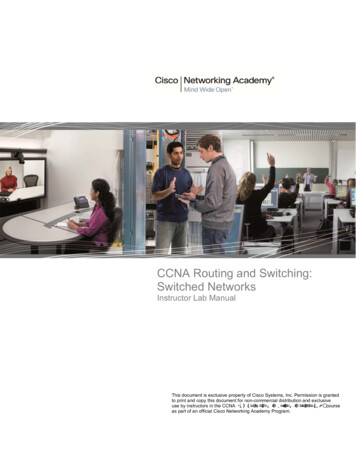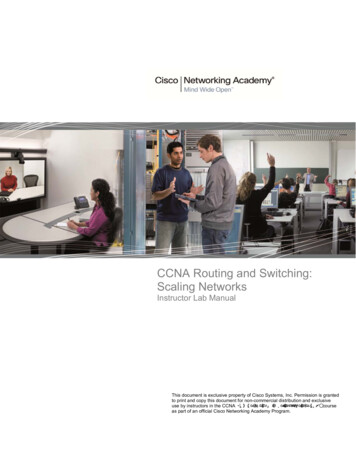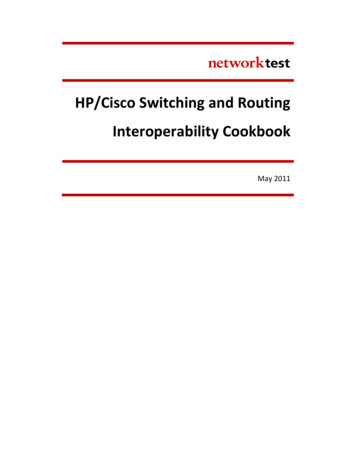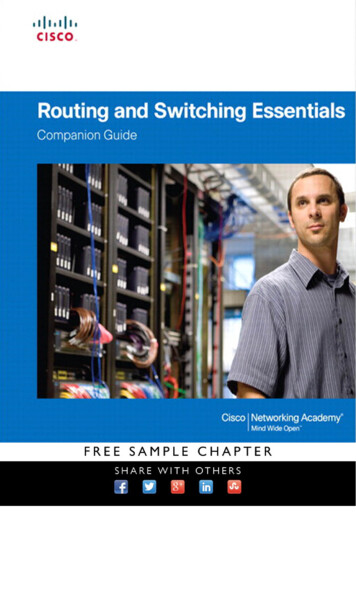
Transcription
Routing and Switching EssentialsCompanion GuideCisco Networking AcademyCisco Press800 East 96th StreetIndianapolis, Indiana 46240 USA
iiRouting and Switching Essentials Companion GuideRouting and Switching EssentialsCompanion GuideCisco Networking AcademyCopyright 2014 Cisco Systems, Inc.Published by:Cisco Press800 East 96th StreetIndianapolis, IN 46240 USAAll rights reserved. No part of this book may be reproduced or transmitted in any formor by any means, electronic or mechanical, including photocopying, recording, or byany information storage and retrieval system, without written permission from the publisher, except for the inclusion of brief quotations in a review.Printed in the United States of AmericaThird Printing: May 2015Library of Congress Control Number: 2013956689ISBN-13: 978-1-58713-318-3ISBN-10: 1-58713-318-0PublisherPaul BogerAssociate PublisherDave DusthimerBusiness OperationManager, Cisco PressJan CornelssenExecutive EditorMary Beth RayManaging EditorSandra SchroederDevelopment EditorEllie C. BruProject EditorMandie FrankCopy EditorApostrophe EditingServicesTechnical EditorKathleen PageWarning and DisclaimerEditorial AssistantVanessa EvansThis book is designed to provide information about the Cisco Networking AcademyRouting and Switching Essentials course. Every effort has been made to make thisbook as complete and as accurate as possible, but no warranty or fitness is implied.DesignerMark ShirarThe information is provided on an “as is” basis. The authors, Cisco Press, and CiscoSystems, Inc. shall have neither liability nor responsibility to any person or entity withrespect to any loss or damages arising from the information contained in this book orfrom the use of the discs or programs that may accompany it.The opinions expressed in this book belong to the author and are not necessarily thoseof Cisco Systems, Inc.CompositionBumpy DesignIndexerKen JohnsonProofreaderDan Knott
iiiTrademark AcknowledgementsAll terms mentioned in this book that are known to be trademarks or service marks have been appropriately capitalized. Cisco Press or Cisco Systems, Inc., cannot attest to the accuracy of this information. Use of a term in thisbook should not be regarded as affecting the validity of any trademark or service mark.Special SalesFor information about buying this title in bulk quantities, or for special sales opportunities (which may includeelectronic versions; custom cover designs; and content particular to your business, training goals, marketingfocus, or branding interests), please contact our corporate sales department at corpsales@pearsoned.com or(800) 382-3419.For government sales inquiries, please contact governmentsales@pearsoned.com.For questions about sales outside the U.S., please contact international@pearsoned.com.Feedback InformationAt Cisco Press, our goal is to create in-depth technical books of the highest quality and value. Each book is craftedwith care and precision, undergoing rigorous development that involves the unique expertise of members from theprofessional technical community.Readers’ feedback is a natural continuation of this process. If you have any comments regarding how we couldimprove the quality of this book, or otherwise alter it to better suit your needs, you can contact us through email atfeedback@ciscopress.com. Please make sure to include the book title and ISBN in your message.We greatly appreciate your assistance.
ivRouting and Switching Essentials Companion GuideAbout the Contributing AuthorsScott Empson is the chair of the Bachelor of Applied Information Systems Technology degree program at the Northern Alberta Institute of Technology in Edmonton, Alberta, Canada, where he teaches Cisco routing, switching, network design,and leadership courses in a variety of different programs (certificate, diploma, andapplied degree) at the postsecondary level.Scott is also the program coordinator of the Cisco Networking Academy Programat NAIT, an Area Support Centre for the province of Alberta. He has been with theCisco Academy since 2000.He has a Masters of Education degree along with three undergraduate degrees: aBachelor of Arts, with a major in English; a Bachelor of Education, again with amajor in English/Language Arts; and a Bachelor of Applied Information SystemsTechnology, with a major in Network Management. He currently holds severalindustry certifications, including CCNP, CCDP, CCAI, C EH and Network . Beforeinstructing at NAIT, he was a junior/senior high school English/Language Arts/Computer Science teacher at different schools throughout Northern Alberta.Scott lives in Edmonton, Alberta, with his wife Trina and two children, Zachariahand Shaelyn.Cheryl Schmidt is a professor at Florida State College at Jacksonville in Jacksonville,Florida, where she teaches courses in networking and PC repair. She has been teaching the academy curriculum since one of the earliest versions.Cheryl has authored multiple books in such areas as PC repair, networking, andvoice over IP. Cheryl also participates on a Cisco Academy team as a subject matterexpert on a team that develops state-of-the-art assessments and courseware.Outside of her academic responsibilities, Cheryl is currently pursuing a Ph.D. ininformation technology. She enjoys spending time with her family, grandkids, andgranddog. She enjoys reading, biking, hiking, and puzzles.
vContents at a GlanceIntroductionxxviiiChapter 1:Introduction to Switched NetworksChapter 2:Basic Switching Concepts and ConfigurationChapter 3:VLANsChapter 4:Routing ConceptsChapter 5:Inter-VLAN RoutingChapter 6:Static RoutingChapter 7:Routing DynamicallyChapter 8:Single-Area OSPFChapter 9:Access Control ListsChapter 10:DHCPChapter 11:Network Address Translation for IPv4Appendix A:Answers to the “Check Your Understanding” 1787695755
viRouting and Switching Essentials Companion GuideContentsIntroductionChapter 1xxviiiIntroduction to Switched Networks1Objectives 1Key Terms1Introduction (1.0.1.1) 2LAN Design (1.1) 2Converged Networks (1.1.1) 3Growing Complexity of Networks (1.1.1.1) 3Elements of a Converged Network (1.1.1.2) 4Borderless Switched Networks (1.1.1.3) 5Hierarchy in the Borderless Switched Network (1.1.1.4)Core Distribution Access (1.1.1.5) 7Switched Networks (1.1.2) 10Role of Switched Networks (1.1.2.1) 10Form Factors (1.1.2.2) 11The Switched Environment (1.2) 14Frame Forwarding (1.2.1) 14Switching as a General Concept in Networking andTelecommunications (1.2.1.1) 14Dynamically Populating a Switch MAC Address Table(1.2.1.2) 15Switch Forwarding Methods (1.2.1.3) 19Store-and-Forward Switching (1.2.1.4) 20Cut-Through Switching (1.2.1.5) 21Switching Domains (1.2.2) 22Collision Domains (1.2.2.1) 22Broadcast Domains (1.2.2.2) 23Alleviating Network Congestion (1.2.2.3) 25Summary (1.3)26Practice 27Class Activities28Packet Tracer Activities28Check Your Understanding Questions286
viiChapter 2Basic Switching Concepts and Configuration33Objectives 33Key Terms33Introduction (2.0.1.1) 35Basic Switch Configuration (2.1) 36Switch Boot Sequence (2.1.1.1) 36Recovering from a System Crash (2.1.1.2)Switch LED Indicators (2.1.1.3)3738Preparing for Basic Switch Management (2.1.1.4)40Configuring Basic Switch Management Access with IPv4(2.1.1.5) 41Configure Switch Ports (2.1.2) 44Duplex Communication (2.1.2.1) 44Configure Switch Ports at the Physical Layer (2.1.2.2) 45Duplex and Speed 45Auto-MDIX (2.1.2.3) 46Verifying Switch Port Configuration (2.1.2.4)Network Access Layer Issues (2.1.2.5)4850Troubleshooting Network Access Layer Issues (2.1.2.6)53Switch Security: Management and Implementation (2.2) 54Secure Remote Access (2.2.1) 54SSH Operation (2.2.1.1) 55Configuring SSH (2.2.1.2) 56Verifying SSH (2.2.1.3) 57Security Concerns in LANs (2.2.2) 59Common Security Attacks: MAC Address Flooding(2.2.2.1) 59Common Security Attacks: DHCP Spoofing (2.2.2.2) 63Common Security Attacks: Leveraging CDP (2.2.2.3) 64Security Best Practices (2.2.3) 66Best Practices (2.2.3.1) 66Network Security Tools and Testing (2.2.3.2) 66Network Security Audits (2.2.3.3) 67Switch Port Security (2.2.4) 68Secure Unused Ports (2.2.4.1) 68DHCP Snooping (2.2.4.2) 69Port Security: Operation (2.2.4.3) 71Port Security: Violation Modes (2.2.4.4) 73Port Security: Configuring (2.2.4.5) 74
viiiRouting and Switching Essentials Companion GuidePort Security: Verifying (2.2.4.6) 75Ports in Error Disabled State (2.2.4.7) 77Network Time Protocol (NTP) (2.2.4.8) 78Summary (2.3)81Practice 83Class ActivitiesLabs8383Packet Tracer Activities 84Check Your Understanding Questions 84Chapter 3VLANs89Objectives 89Key Terms89Introduction (3.0.1.1) 90VLAN Segmentation (3.1) 91VLAN Definitions (3.1.1.1)91Benefits of VLANs (3.1.1.2)92Types of VLANs (3.1.1.3) 93Data VLAN 93Default VLAN 93Native VLAN 94Management VLAN 95Voice VLANs (3.1.1.4) 96VLANs in a Multiswitched Environment (3.1.2)VLAN Trunks (3.1.2.1)9797Controlling Broadcast Domains with VLANs (3.1.2.2) 98Network Without VLANs 98Network with VLANs 99Tagging Ethernet Frames for VLAN Identification (3.1.2.3)Native VLANs and 802.1Q Tagging (3.1.2.4) 102Tagged Frames on the Native VLAN 102Untagged Frames on the Native VLAN 102Voice VLAN Tagging (3.1.2.5) 103Sample Configuration 104VLAN Implementations (3.2) 105VLAN Ranges on Catalyst Switches (3.2.1.1) 105Creating a VLAN (3.2.1.2) 106101
ixAssigning Ports to VLANs (3.2.1.3) 108Changing VLAN Port Membership (3.2.1.4) 109Deleting VLANs (3.2.1.5) 111Verifying VLAN Information (3.2.1.6) 112VLAN Trunks (3.2.2) 114Configuring IEEE 802.1Q Trunk Links (3.2.2.1) 114Resetting the Trunk to Default State (3.2.2.2) 116Verifying Trunk Configuration (3.2.2.3) 118Dynamic Trunking Protocol (3.2.3) 120Introduction to DTP (3.2.3.1) 120Negotiated Interface Modes (3.2.3.2) 121Troubleshoot VLANs and Trunks (3.2.4) 123IP Addressing Issues with VLAN (3.2.4.1) 123Missing VLANs (3.2.4.2) 125Introduction to Troubleshooting Trunks (3.2.4.3) 127Common Problems with Trunks (3.2.4.4) 128Trunk Mode Mismatches (3.2.4.5) 129Incorrect VLAN List (3.2.4.6) 131VLAN Security and Design (3.3) 134Switch Spoofing Attack (3.3.1.1) 134Double-Tagging Attack (3.3.1.2) 135PVLAN Edge (3.3.1.3) 136Design Best Practices for VLANs (3.3.2) 138VLAN Design Guidelines (3.3.2.1) 138Summary (3.4) 140Practice 142Class ActivitiesLabs142142Packet Tracer Activities 143Check Your Understanding Questions 143Chapter 4Routing Concepts 149Objectives 149Key Terms149Introduction (4.0.1.1) 151
xRouting and Switching Essentials Companion GuideFunctions of a Router (4.1.1)152Characteristics of a Network (4.1.1.1)Why Routing? (4.1.1.2)152153Routers Are Computers (4.1.1.3)154Routers Interconnect Networks (4.1.1.4)Routers Choose Best Paths (4.1.1.5)156158Packet-Forwarding Mechanisms (4.1.1.6)Connect Devices (4.1.2)158162Connect to a Network (4.1.2.1)Default Gateways (4.1.2.2)162164Document Network Addressing (4.1.2.3)Enable IP on a Host (4.1.2.4)Device LEDs (4.1.2.5)165166167Console Access (4.1.2.6)169Enable IP on a Switch (4.1.2.7)171Basic Settings on a Router (4.1.3)172Configure Basic Router Settings (4.1.3.1)172Configure an IPv4 Router Interface (4.1.3.2)175Configure an IPv6 Router Interface (4.1.3.3)177Configure an IPv4 Loopback Interface (4.1.3.4)181Verify Connectivity of Directly Connected Networks (4.1.4)Verify Interface Settings (4.1.4.1)183Verify IPv6 Interface Settings (4.1.4.2)186Filter Show Command Output (4.1.4.3)Command History Feature (4.1.4.4)189191Switching Packets Between Networks (4.2.1)Router Switching Function (4.2.1.1)Send a Packet (4.2.1.2)194Forward to the Next Hop (4.2.1.3)Packet Routing (4.2.1.4)197198Routing Decisions (4.2.2.1)Best Path (4.2.2.2)195196Reach the Destination (4.2.1.5)Path Determination (4.2.2)193198199Load Balancing (4.2.2.3)200Administrative Distance (4.2.2.4)200193183
xiAnalyze the Routing Table (4.3.1) 202The Routing Table (4.3.1.1) 202Routing Table Sources (4.3.1.2) 203Remote Network Routing Entries (4.3.1.3) 204Directly Connected Routes (4.3.2) 205Directly Connected Interfaces (4.3.2.1) 205Directly Connected Routing Table Entries (4.3.2.2) 206Directly Connected Examples (4.3.2.3) 207Directly Connected IPv6 Example (4.3.2.4) 210Statically Learned Routes (4.3.3) 214Static Routes (4.3.3.1) 214Static Route Examples (4.3.3.2) 214Static IPv6 Route Examples (4.3.3.3) 216Dynamic Routing Protocols (4.3.4) 219Dynamic Routing (4.3.4.1) 219IPv4 Routing Protocols (4.3.4.2) 220IPv4 Dynamic Routing Examples (4.3.4.3) 221IPv6 Routing Protocols (4.3.4.4) 222IPv6 Dynamic Routing Examples (4.3.4.5) 223Summary (4.4) 224Practice 225Class ActivitiesLabs225226Packet Tracer Activities 226Check Your Understanding Questions 226Chapter 5Inter-VLAN Routing 231Objectives 231Key Terms231Introduction (5.0.1.1) 232Inter-VLAN Routing Configuration (5.1) 232What Is Inter-VLAN Routing? (5.1.1.1)Legacy Inter-VLAN Routing (5.1.1.2)233233Router-on-a-Stick Inter-VLAN Routing (5.1.1.3)235Multilayer Switch Inter-VLAN Routing (5.1.1.4)237
xiiRouting and Switching Essentials Companion GuideConfigure Legacy Inter-VLAN Routing (5.1.2)239Configure Legacy Inter-VLAN Routing: Preparation(5.1.2.1) 239Configure Legacy Inter-VLAN Routing: Switch Configuration(5.1.2.2) 240Configure Legacy Inter-VLAN Routing: Router InterfaceConfiguration (5.1.2.3) 241Configure Router-on-a-Stick Inter-VLAN Routing (5.1.3) 244Configure Router-on-a-Stick: Preparation (5.1.3.1)244Configure Router-on-a-Stick: Switch Configuration(5.1.3.2) 245Configure Router-on-a-Stick: Router Subinterface Configuration(5.1.3.3) 246Configure Router-on-a-Stick: Verifying Subinterfaces(5.1.3.4) 248Configure Router-on-a-Stick: Verifying Routing (5.1.3.5)Ping Test 251Tracert Test 251250Troubleshoot Inter-VLAN Routing (5.2) 252Inter-VLAN Configuration Issues (5.2.1) 252Switch Port Issues (5.2.1.1) 252Verify Switch Configuration (5.2.1.2) 254Interface Issues (5.2.1.3) 255Verify Router Configuration (5.2.1.4) 256IP Addressing Issues (5.2.2) 258Errors with IP Addresses and Subnet Masks (5.2.2.1) 258Verifying IP Address and Subnet Mask ConfigurationIssues (5.2.2.2) 260Layer 3 Switching (5.3)261Introduction to Layer 3 Switching (5.3.1.1)261Inter-VLAN Routing with Switch Virtual Interfaces (5.3.1.2,5.3.1.3) 263Inter-VLAN Routing with Routed Ports (5.3.1.4) 265Routed Ports and Access Ports on a Switch 265Configuring Static Routes on a Catalyst 2960 (5.3.1.5) 266Troubleshoot Layer 3 Switching (5.3.2) 274Layer 3 Switch Configuration Issues (5.3.2.1) 274Example: Troubleshooting Layer 3 Switching (5.3.2.2) 275
xiiiSummary (5.4)278Practice 279Class ActivitiesLabs279279Packet Tracer Activities 279Check Your Understanding Questions 280Chapter 6Static Routing 283Objectives 283Key Terms283Introduction (6.0.1.1) 285Static Routing (6.1.1) 286Reach Remote Networks (6.1.1.1) 286Why Use Static Routing? (6.1.1.2) 286When to Use Static Routes (6.1.1.3) 288Types of Static Routes289Static Route Applications (6.1.2.1)Standard Static Route (6.1.2.2)Default Static Route (6.1.2.3)290Summary Static Route (6.1.2.4)Floating Static Route (6.1.2.5)289289290291Configure IPv4 Static Routes (6.2.1)ip route Command (6.2.1.1)292Next-Hop Options (6.2.1.2)293292Configure a Next-Hop Static Route (6.2.1.3)297Configure a Directly Connected Static Route (6.2.1.4)Configure a Fully Specified Static Route (6.2.1.5)Verify a Static Route (6.2.1.6)304Configure IPv4 Default Routes (6.2.2)Default Static Route (6.2.2.1)306306Configure a Default Static Route (6.2.2.2)Verify a Default Static Route (6.2.2.3)Configure IPv6 Static Routes (6.2.3)308310The ipv6 route Command (6.2.3.1) 310Next-Hop Options (6.2.3.2) 311307301299
xivRouting and Switching Essentials Companion GuideConfigure a Next-Hop Static IPv6 Route (6.2.3.3)315Configure a Directly Connected Static IPv6 Route (6.2.3.4)Configure a Fully Specified Static IPv6 Route (6.2.3.5)Verify IPv6 Static Routes (6.2.3.6)320Configure IPv6 Default Routes (6.2.4)322Default Static IPv6 Route (6.2.4.1)322Configure a Default Static IPv6 Route (6.2.4.2)Verify a Default Static Route (6.2.4.3)Review of CIDR and VLSM (6.3)323325Classful Network Addressing (6.3.1.1)Classful Subnet Masks (6.3.1.2)326327Classful Routing Protocol Example (6.3.1.3)Classful Addressing Waste (6.3.1.4)CIDR (6.3.2)328329331Classless Inter-Domain Routing (6.3.2.1)331CIDR and Route Summarization (6.3.2.2)Static Routing CIDR Example (6.3.2.3)332333Classless Routing Protocol Example (6.3.2.4)VLSM (6.3.3)323335335Fixed-Length Subnet Masking (6.3.3.1)336Variable-Length Subnet Masking (6.3.3.2)VLSM in Action (6.3.3.3)338Subnetting Subnets (6.3.3.4)VLSM Example (6.3.3.5)337339341Configure IPv4 Summary Routes (6.4.1)346Route Summarization (6.4.1.1) 346Calculate a Summary Route (6.4.1.2) 346Summary Static Route Example (6.4.1.3) 348Configure IPv6 Summary Routes (6.4.2)352Summarize IPv6 Network Addresses (6.4.2.1)Calculate IPv6 Summary Addresses (6.4.2.2)354Configure an IPv6 Summary Address (6.4.2.3)Configure Floating Static Routes (6.4.3)Floating Static Routes (6.4.3.1)352356358358Configure a Floating Static Route (6.4.3.2)Test the Floating Static Route (6.4.3.3)360359319317
xvTroubleshoot Static and Default Route Issues (6.5) 363Static Routes and Packet Forwarding (6.5.1.1) 364Troubleshoot a Missing Route (6.5.2.1) 364Solve a Connectivity Problem (6.5.2.2) 368Summary (6.6) 373Practice 374Class ActivitiesLabs375375Packet Tracer Activities 375Check Your Understanding Questions 376Chapter 7Routing Dynamically 379Objectives 379Key Terms379Introduction (7.0.1.1) 381Dynamic Routing Protocol Operation (7.1.1) 382The Evolution of Dynamic Routing Protocols (7.1.1.1)Purpose of Dynamic Routing Protocols (7.1.1.2)383The Role of Dynamic Routing Protocols (7.1.1.3)Dynamic Versus Static Routing (7.1.2)Using Static Routing (7.1.2.1)384385386Static Routing Scorecard (7.1.2.2)386Using Dynamic Routing Protocols (7.1.2.3)Dynamic Routing Scorecard (7.1.2.4)387388Routing Protocol Operating Fundamentals (7.1.3) 389Dynamic Routing Protocol Operation (7.1.3.1)Cold Start (7.1.3.2)389390Network Discovery (7.1.3.3)391Exchanging the Routing Information (7.1.3.4)Achieving Convergence (7.1.3.5)Types of Routing Protocols (7.1.4)392394396Classifying Routing Protocols (7.1.4.1)396IGP and EGP Routing Protocols (7.1.4.2)399Distance Vector Routing Protocols (7.1.4.3)Link-State Routing Protocols (7.1.4.4)402401382
xviRouting and Switching Essentials Companion GuideClassful Routing Protocols (7.1.4.5)402Classless Routing Protocols (7.1.4.6)406Routing Protocol Characteristics (7.1.4.7)Routing Protocol Metrics (7.1.4.8)409410Distance Vector Routing Protocol Operation (7.2.1) 411Distance Vector Technologies (7.2.1.1)Distance Vector Algorithm (7.2.1.2)411412Types of Distance Vector Routing Protocols (7.2.2)Routing Information Protocol (7.2.2.1)413413Enhanced Interior-Gateway Routing Protocol (7.2.2.2)RIP and RIPng Routing (7.3)416Router RIP Configuration Mode (7.3.1.1)Advertising Networks (7.3.1.2)416418Examining Default RIP Settings (7.3.1.3)Enabling RIPv2 (7.3.1.4)415419421Disabling Auto Summarization (7.3.1.5)423Configuring Passive Interfaces (7.3.1.6)425Propagating a Default Route (7.3.1.7)Configuring the RIPng Protocol (7.3.2)Advertising IPv6 Networks (7.3.2.1)427429429Examining the RIPng Configuration (7.3.2.2)430Link-State Dynamic Routing (7.4) 433Shortest Path First Protocols (7.4.1.1) 433Dijkstra’s Algorithm (7.4.1.2)SPF Example (7.4.1.3)434435Link-State Updates (7.4.2)438Link-State Routing Process (7.4.2.1)Link and Link-State (7.4.2.2)Say Hello (7.4.2.3)438438442Building the Link-State Packet (7.4.2.4)Flooding the LSP (7.4.2.5)442443Building the Link-State Database (7.4.2.6)Building the SPF Tree (7.4.2.7)443445Adding OSPF Routes to the Routing Table (7.4.2.8)446
xviiWhy Use Link-State Routing Protocols (7.4.3) 447Why Use Link-State Protocols? (7.4.3.1) 447Disadvantages of Link-State Protocols (7.4.3.2) 448Protocols That Use Link-State (7.4.3.3) 449Parts of an IPv4 Route Entry (7.5.1) 449Routing Table Entries (7.5.1.1) 449Directly Connected Entries (7.5.1.2) 451Remote Network Entries (7.5.1.3) 453Dynamically Learned IPv4 Routes (7.5.2) 454Routing Table Terms (7.5.2.1) 454Ultimate Route (7.5.2.2) 455Level 1 Route (7.5.2.3) 455Level 1 Parent Route (7.5.2.4) 456Level 2 Child Route (7.5.2.5) 458The IPv4 Route Lookup Process (7.5.3) 460Route Lookup Process (7.5.3.1) 460Best Route Longest Match (7.5.3.2) 462Analyze an IPv6 Routing Table (7.5.4) 463IPv6 Routing Table Entries (7.5.4.1) 463Directly Connected Entries (7.5.4.2) 464Remote IPv6 Network Entries (7.5.4.3) 466Summary (7.6) 469Practice 470Class ActivitiesLabs470471Packet Tracer Activities 471Check Your Understanding Questions 471Chapter 8Single-Area OSPF 475Objectives 475Key Terms475Introduction (8.0.1.1) 477Characteristics of OSPF (8.1) 477Evolution of OSPF (8.1.1.1)Features of OSPF (8.1.1.2)477479
xviiiRouting and Switching Essentials Companion GuideComponents of OSPF (8.1.1.3) 479Data Structures 479Routing Protocol Messages 480Algorithm 481Link-State Operation (8.1.1.4) 481Single-Area and Multiarea OSPF (8.1.1.5)OSPF Messages (8.1.2)487Encapsulating OSPF Messages (8.1.2.1)Types of OSPF Packets (8.1.2.2)Hello Packet (8.1.2.3)487489489Hello Packet Intervals (8.1.2.4)Link-State Updates (8.1.2.5)OSPF Operation (8.1.3)484491492493OSPF Operational States (8.1.3.1)493Establish Neighbor Adjacencies (8.1.3.2)OSPF DR and BDR (8.1.3.3)494496Synchronizing OSPF Databases (8.1.3.4)497Configuring Single-Area OSPFv2 (8.2.1) 500OSPF Network Topology (8.2.1.1)500Router OSPF Configuration Mode (8.2.1.2)Router IDs (8.2.1.3)501502Configuring an OSPF Router ID (8.2.1.4)Modifying a Router ID (8.2.1.5)503505Using a Loopback Interface as the Router ID (8.2.1.6)Configure Single-Area OSPFv2 (8.2.2) 507Enabling OSPF on Interfaces (8.2.2.1)Wildcard Mask (8.2.2.2)508The network Command (8.2.2.3)Passive Interface (8.2.2.4)507509510Configuring Passive Interfaces (8.2.2.5)OSPF Cost (8.2.3)511512OSPF Metric Cost (8.2.3.1)513OSPF Accumulates Costs (8.2.3.2)514Adjusting the Reference Bandwidth (8.2.3.3) 515Adjusting the Reference Bandwidth 515Default Interface Bandwidths (8.2.3.4) 519507
xixAdjusting the Interface Bandwidths (8.2.3.5)Manually Setting the OSPF Cost (8.2.3.6)Verify OSPF (8.2.4)521522523Verify OSPF Neighbors (8.2.4.1)523Verify OSPF Protocol Settings (8.2.4.2)525Verify OSPF Process Information (8.2.4.3)Verify OSPF Interface Settings (8.2.4.4)OSPFv2 vs. OSPFv3 (8.3.1)OSPFv3 (8.3.1.1)526526527528Similarities Between OSPFv2 to OSPFv3 (8.3.1.2)529Differences Between OSPFv2 and OSPFv3 (8.3.1.3)Link-Local Addresses (8.3.1.4)Configuring OSPFv3 (8.3.2)530531OSPFv3 Network Topology (8.3.2.1)Link-Local Addresses (8.3.2.2)531533Assigning Link-Local Addresses (8.3.2.3)534Configuring the OSPFv3 Router ID (8.3.2.4)Modifying an OSPFv3 Router ID (8.3.2.5)Enabling OSPFv3 on Interfaces (8.3.2.6)Verify OSPFv3 (8.3.3)539540Verify OSPFv3 Protocol Settings (8.3.3.2)Verify OSPFv3 Interfaces (8.3.3.3)544Practice 545Labs545545Packet Tracer Activities 546Check Your Understanding Questions 546Chapter 9Access Control Lists 549Objectives 549Key Terms549Introduction (9.0.1.1) 550541542Verify the IPv6 Routing Table (8.3.3.4)Class Activities538540Verify OSPFv3 Neighbors (8.3.3.1)Summary (8.4)535543529
xxRouting and Switching Essentials Companion GuideIP ACL Operation (9.1)551What Is an ACL? (9.1.1.1)551A TCP Conversation (9.1.1.2) 552TCP Communication 552Packet Filtering (9.1.1.3, 9.1.1.4) 555ACL Operation (9.1.1.5) 557Standard Versus Extended IPv4 ACLS (9.1.2) 558Types of Cisco IPv4 ACLs (9.1.2.1) 558Standard ACLs 558Extended ACLs 559Numbering and Naming ACLs (9.1.2.2) 559Wildcard Masks in ACLs (9.1.3)560Introducing ACL Wildcard Masking (9.1.3.1) 560Wildcard Masking 560Using a Wildcard Mask 562Wildcard Mask Examples (9.1.3.2) 562Wildcard Masks to Match IPv4 Subnets 562Wildcard Masks to Match Ranges 563Calculating the Wildcard Mask (9.1.3.3) 564Wildcard Mask Keywords (9.1.3.4) 565Wildcard Bit Mask Keywords 566Examples Wildcard Mask Keywords (9.1.3.5)The any and host Keywords 567567Guidelines for ACL Creation (9.1.4) 568General Guidelines for Creating ACLs (9.1.4.1) 568ACL Best Practices (9.1.4.2) 569Guidelines for ACL Placement (9.1.5) 570Where to Place ACLs (9.1.5.1) 570Standard ACL Placement (9.1.5.2) 571Extended ACL Placement (9.1.5.3) 573Standard IPv4 ACLs (9.2) 574Entering Criteria Statements (9.2.1.1) 574Configuring a Standard ACL – Standard ACL Logic(9.2.1.2) 575Configuring a Standard ACL – Configuring Standard ACLs(9.2.1.3) 576Internal Logic (9.2.1.4)578
xxiApplying Standard ACLs to Interfaces – Standard ACLConfiguration Procedures (9.2.1.5, 9.2.1.6) 579Creating Named Standard ACLs (9.2.1.7)Commenting ACLs (9.2.1.8)Modify IPv4 ACLs (9.2.2)582584586Editing Standard Numbered ACLs (9.2.2.1, 9.2.2.2)Method 1: Using a Text Editor 586Method 2: Using the Sequence Number 587Editing Standard Named ACLs (9.2.2.3) 589Verifying ACLs (9.2.2.4)ACL Statistics (9.2.2.5)586590591Standard ACL Sequence Numbers (9.2.2.6)592Securing VTY Ports with a Standard IPv4 ACL (9.2.3)595Configuring a Standard ACL to Secure a VTY Port(9.2.3.1) 595Verifying a Standard ACL Used to Secure a VTY Port(9.2.3.2) 596Structure of an Extended IPv4 ACL (9.3.1) 598Extended ACLs – Testing Packets with Extended ACLs(9.3.1.1) 598Extended ACLs – Testing for Ports and Services (9.3.1.2)Configure Extended IPv4 ACLs (9.3.2)Configuring Extended ACLs (9.3.2.1)601601Applying Extended ACLs to Interfaces (9.3.2.2)Filtering Traffic with Extended ACLs (9.3.2.3)Creating Named Extended ACLs (9.3.2.4)Verifying Extended ACLs (9.3.2.5)Editing Extended ACLs (9.3.2.6)Troubleshoot ACLs (9.4)603605606607608611Inbound and Outbound ACL Logic (9.4.1.1)ACL Logic Operations (9.4.1.2)613Standard ACL Decision Process (9.4.1.3)Extended ACL Decision Process (9.4.1.4)Common ACL Errors (9.4.2)611614615616Troubleshooting Common ACL Errors - Example 1(9.4.2.1) 616599
xxiiRouting and Switching Essentials Companion GuideTroubleshooting Common ACL Errors - Example 2(9.4.2.2) 617Troubleshooting Common ACL Errors - Example 3(9.4.2.3) 618Troubleshooting Common ACL Errors - Example 4(9.4.2.4) 619Troubleshooting Common ACL Errors - Example 5(9.4.2.5) 619IPv6 ACLs (9.5)621Type of IPv6 ACLs (9.5.1.1)621Comparing IPv4 and IPv6 ACLs (9.5.1.2)Configuring IPv6 Topology (9.5.2.1)Configuring IPv6 ACLs (9.5.2.2)621623625Applying an IPv6 ACL to an Interface (9.5.2.3)627IPv6 ACL Examples (9.5.2.4) 628Deny FTP 629Restricted Access 629Verifying IPv6 ACLs (9.5.2.5) 630Summary (9.6)633Practice 635Class ActivitiesLabs635635Packet Tracer Activities 635Check Your Understanding Questions 636Chapter 10DHCP639Objectives 639Key Terms639Introduction (10.0.1.1) 640Dynamic Host Configuration Protocol v4 (10.1) 641Introducing DHCPv4 (10.1.1.1)641DHCPv4 Operation (10.1.1.2) 642Lease Origination 642Lease Renewal 644DHCPv4 Message Format (10.1.1.3)645DHCPv4 Discover and Offer Messages (10.1.1.4)646
xxiiiConfiguring a Basic DHCPv4 Server (10.1.2) 648Configuring a Basic DHCPv4 Server (10.1.2.1) 648DHCPv4 Example 651Disabling DHCPv4 651Verifying DHCPv4 (10.1.2.2) 651DHCPv4 Relay (10.1.2.3) 655What Is DHCP Relay? 655Configure DHCPv4 Client (10.1.3) 659Configuring a Router as DHCPv4 Client (10.1.3.1) 659Configuring a SOHO Router as a DHCPv4 Client (10.1.3.2) 660Troubleshoot DHCPv4 (10.1.4) 661Troubleshooting Tasks (10.1.4.1) 661Troubleshooting Task 1: Resolve IPv4 AddressConflicts 662Troubleshooting Task 2: Verify PhysicalConnectivity 662Troubleshooting Task 3: Test Connectivity Using a StaticIP Address 662Troubleshooting Task 4: Verify Switch PortConfiguration 662Troubleshooting Task 5: Test DHCPv4 Operation on theSame Subnet or VLAN 663Verify Router DHCPv4 Configuration (10.1.4.2) 663Debugging DHCPv4 (10.1.4.3) 664Dynamic Host Configuration Protocol v6 (10.2) 665Stateless Address Autoconfiguration (SLAAC) (10.2.1.1) 665SLAAC Operation (10.2.1.2) 666SLAAC and DHCPv6 (10.2.1.3) 668SLAAC Option (10.2.1.4) 669SLAAC Option (Router Advertisement Only) 669Stateless DHCPv6 Option (10.2.1.5) 670Stateless DHCPv6 Option (Router Advertisement andDHCPv6) 670Stateful DHCPv6 Option (10.2.1.6) 671Stateful DHCPv6 (DHCPv6 Only) 671DHCPv6 Operations (10.2.1.7) 671DHCPv6 Communications 672Stateless DHCPv6 (10.2.2) 673Configuring a Router as a Stateless DHCPv6 Server(10.2.2.1) 673
xxivRouting and Switching Essentials Companion GuideDHCPv6 Stateless Server Example 674Configuring a Router as a Stateless DHCPv6 Client(10.2.2.2) 675Verifying Stateless DHCPv6 (10.2.2.3) 675Verifying the Stateless DHCPv6 Server 675Verifying the Stateless DHCPv6 Client 676Stateful DHCPv6 Server (10.2.3) 678Configuring a Router as a Stateful DHCPv6 Server(10.2.3.1) 678DHCPv6 Stateful Server Example 679Configuring a Router as a Stateful DHCPv6 Client(10.2.3.2) 679Verifying Stateful DHCPv6 (10.2.3.3) 680Verifying the Stateful DHCPv6 Client 681Configuring a Router as a DHCPv6 Relay Agent (10.2.3.4)Configuring the DHCPv6 Relay Agent 683682Troubleshoot DHCPv6 (10.2.4) 683Troubleshooting Tasks (10.2.4.1) 683Troubleshooting Task 1. Resolve Conflicts 684Troubleshooting Task 2. Verify Allocation Method 684Troubleshooting Task 3. Test with a Static IPv6Address 684Troubleshooting Task 4. Verify Switch PortConfiguration 684Troubleshooting Task 5. Test DHCPv6 Operation on theSame Subnet or VLAN 684Verify Router DHCPv6 Configuration (10.2.4.2) 685Stateful DHCPv6 685Stateless DHCPv6 685Debugging DHCPv6 (10.2.4.3) 686Summary (10.3)688Practice 690Class Activities690Packet Tracer Activities690Check Your Understanding QuestionsChapter 11691Network Address Translation for IPv4Objectives 695Key Terms695695
xxvIntroduction (11.0.1.1) 696NAT Operation (11.1) 697IPv4 Private Address Space (11.1.1.1) 697What Is NAT? (11.1.1.2) 698NAT Terminology (11.1.1.3, 11.1.1.4)How NAT Works (11.1.1.5)Types of NAT (11.1.2)699702703Static NAT (11.1.2.1)703Dynamic NAT (11.1.2.2)704Port Address Translation (PAT) (11.1.2.3)Next Available Port (11.1
Florida, where she teaches courses in networking and PC repair. She has been teach-ing the academy curriculum since one of the earliest versions. Cheryl has authored multiple books in such areas as PC repair, networking, and voice over IP. Cheryl also
